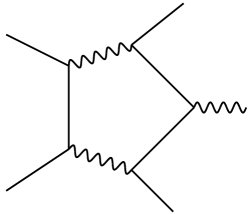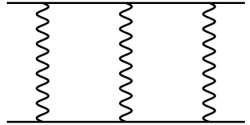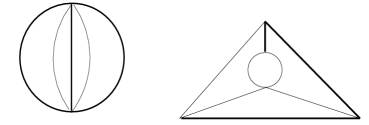AMBRE
- Automatic Mellin-Barnes Representation
and
calculation of Feynman integrals
Ievgen
Dubovyk (DESY, e.a.dubovyk,gmail.com),
J. Gluza (U.
of Silesia,
janusz.gluza,us.edu.pl),
K. Kajda (U.
of Silesia, now at IT company, kajda.krzysztof,gmail.com),
T.
Riemann (DESY, tord.riemann,desy.de)
Publications
on the AMBRE project
AMBRE
v3.1, AMBREv2.1, AMBREv1.3 [Updates for versions 1,2,3]
Authors:
I. Dubovyk, J. Gluza, K. Kajda, T. Riemann
"Numerical integration of massive two-loop
Mellin-Barnes integrals in Minkowskian regions “,
Ievgen Dubovyk, Janusz Gluza, Tord Riemann, Johann Usovitsch,
http://arxiv.org/abs/arXiv:1607.07538
AMBRE
v3.0 [Global approach, optimized for non-planar two-loop cases, see Features in v3.0 description for details.]
Authors:
I. Dubovyk, J. Gluza, K. Kajda, T. Riemann
Publication: section „Construction of Mellin-Barnes integrals in „Non-planar
Feynman integrals, Mellin-Barnes , representations, multiple sums “,
J.
Blümlein, I. Dubovyk, J. Gluza, M. Ochman, C.G. Raab, T. Riemann, C.
Schneider, PoS(LL2014)052
http://arxiv.org/abs/arXiv:1407.7832
AMBREv2.0 [Loop-by-loop approach, optimized for planar cases, covers also features of v1.2]
Authors:
J. Gluza, K. Kajda, T. Riemann
Publication: „
Numerical
Evaluation of Tensor Feynman Integrals in Euclidean Kinematics“,
J.
Gluza, K. Kajda, T. Riemann, V. Yundin, Eur.
Phys. J. C71 (2011) 1516, DOI:
http://dx.doi.org/10.1140/epjc/s10052-010-1516-y
http://arxiv.org/abs/arXiv:1010.1667
AMBRE
v1.0
Authors:
J. Gluza, K. Kajda, T. Riemann
Publication:„AMBRE:
A Mathematica package for the construction of Mellin-Barnes
representations for Feynman integrals“
J.
Gluza, K. Kajda, T. Riemann, Comput.
Phys. Commun. 177 (2007) 879, DOI:
http://dx.doi.org/10.1016/j.cpc.2007.07.001
http://arxiv.org/abs/arXiv:0704.2423
Further publications on
the AMBRE project
„
Some Remarks on Non-planar Feynman Diagrams“,
K. Bielas, I. Dubovyk, J. Gluza, T. Riemann,
Contrib. to Int.
Conf. „Matter to the deepest“, 1-6 Sep. 2013, Ustron, Poland
Acta
Phys.Polon. B44 (2013) 2249,
DOI: http://dx.doi.org/10.5506/APhysPolB.44.2249
http://arxiv.org/abs/arXiv:1312.5603
„News
on Ambre [v1.2] and CSectors“, J.
Gluza, K. Kajda, T. Riemann, V. Yundin
Contrib.
to Proc. of „Loops and Legs in Quantum Field Theory“', 25-30
April 2010, Wörlitz, Germany
Nucl.
Phys. Proc. Suppl. 205-206 (2010)
147,
DOI: http://dx.doi.org/10.1016/j.nuclphysbps.2010.08.034
http://arxiv.org/abs/arXiv:1006.4728
„New
results for loop integrals: AMBRE [v1.0], CSectors, hexagon“
, J.
Gluza, K. Kajda, T. Riemann, V. Yundin
Contrib.
to Proc. of „Workshop on advanced computing and analysis techniques
in physics research“, ACAT 2008), 3-7 Nov. 2008 Erice, Italy
PoS
ACAT08 (2008) 124,
http://pos.sissa.it/archive/conferences/070/124/ACAT08_124.pdf
http://arxiv.org/abs/arXiv:0902.4830
HEPFORGE
HEPFORGE
is a development environment for high energy physics software
projects.
See:
https://www.hepforge.org/.
AMBRE
is part of a collection of tools devoted to the evaluation of
Mellin-Barnes integrals collected
at HEPFORGE. Most of the AMBRE applications make use of the
Mathematica package MB by M. Czakon. There you can also find links to
the numerical libraries CUBA of T. Hahn and CERNlib (in fact, only
libmathlib.a and libkernlib.a are required) which are used by the MB
package.
For MB, see:
https://mbtools.hepforge.org/.
For CUBA,
see: http://www.feynarts.de/cuba/.
For
CERNlib, see: http://cernlib.web.cern.ch/cernlib/.
Related
and auxiliary Software
MBnumerics
Project:
I. Dubovyk, T. Riemann, J. Usovitsch (jusovitsch,googlemail.com)
Software:
Johann Usovitsch
Publications:
https://doi.org/10.18452/19484
, https://doi.org/10.1016/j.cpc.2006.07.002, https://doi.org/10.1016/j.physletb.2016.09.012
To be cited by users in publications, for details see README_copyright in the downloaded tarball.
Features:
MBnumerics is a software for evaluation of MB integrals in the Minkowski kinematics
Download:
packages/mbnumerics.tgz
MBsums
Project:
Michal Ochman, Tord Riemann (ochman.michal,gmail.com)
Software:
Michal Ochman
(i) When using MBsums, please quote [1].
(ii) Please do not share/distribute/publish derivatives of MBsums without written permission of the project authors.
Main publication:
[1] M. Ochman, T. Riemann, "MBsums, a Mathematica package for the 2 representation of Mellin-Barnes integrals
by multiple sums",
Acta Phys. Polon. 46 (2015) 2117, arXiv:1511.01323.
[2] An extended version of the description of MBsums, DESY 15-209, was submitted to the arXiv: hep-ph/1511.01323.
Features:
MBsums is a Mathematica package representing multiple MB-integrals by multiple sums.
Download:
http://jgluza.us.edu.pl/ambre/MBsums/MBsums.v1.0.3.m
(CC
BY-ND, the CPC licence, http://cpc.cs.qub.ac.uk/licence/licence.html ).
Examples:
1lbox.nb
[1lbox.pdf],
2lbox-m0.nb
[2lbox-m0.pdf],
2lbox.nb
[2lbox.pdf],
dim3.nb
[dim3.pdf]
Csectors
Project:
J. Gluza, K.
Kajda, T. Riemann, V. Yundin (yuvaleriy,gmail.com)
Software:
J. Gluza, K. Kajda, V. Yundin
Main
publication: J.
Gluza, K. Kajda, T. Riemann, V. Yundin, PoS ACAT08 (2008) 124.
To be cited by users in publications.
Features:
CSectors
is a Mathematica interface to sector_decomposition, a Ginac package
for the numerical calculation of multiloop tensor integrals.
Download:
For sector_decomposition, see:
http://wwwthep.physik.uni-mainz.de/~stefanw/sector_decomposition/
For
Csectors, see: http://jgluza.us.edu.pl/csectors/
(CC BY-ND)
For
Ginac see: http://www.ginac.de/
PlanarityTest
Project:
K. Bielas
(krzysiek.bielas,gmail.com),
I. Dubovyk, J. Gluza, T. Riemann
Software:
K. Bielas, I. Dubovyk
Main
publication: K.
Bielas, I. Dubovyk, J. Gluza, T. Riemann,
Acta
Phys.Polon. B44 (2013)
(2013)
2249.
To be cited by users in publications.
Features:
PlanarityTest is a
Mathematica package for testing the planarity of Feynman
diagrams.
Download:
http://jgluza.us.edu.pl/ambre/planarity/
(CC
BY-ND).
KinematicsGen
Project
and Software: K. Kajda, J. Gluza
Features:
Kinematics generator for 4-, 5-, and 6-point functions with arbitrary
external legs.
Download:
http://jgluza.us.edu.pl/ambre/packages/KinematicsGen.m
(CC
BY-ND).
Examples:
http://jgluza.us.edu.pl/ambre/examples/MomentaGenExamples.nb
HPL4
Package:
T. Riemann
(tordriemann,gmail.com)
Main
publication:
M. Czakon, J. Gluza, T. Riemann,
Phys.Rev. D71 (2005) 073009, hep-ph/0412164. To be cited by users in publications.
Features:
HPL4 is a numerical package for harmonic polylogarithms of weights 1-4.
Download:
http://jgluza.us.edu.pl/ambre/packages/HPLnum.m
(CC
BY-ND).
The
AMBRE project and software: Packages and Samples
Project
authors:
I.
Dubovyk, J. Gluza, K. Kajda, T. Riemann
Copyright statement:
The authors teams of publications,
projects, and software packages related to AMBRE are not necessarily
identical. The individual software packages have their own copyright
statements = conditions of use, formulated by the authors of that
software. They should be reproduced in the distributed package.
Globally, the authors expect credit
by:
(i) Appropriately mentioning that
software of the AMBRE project has been used.
(ii) Appropriately citing, for that
use, the references which have been named by the authors.
Users may, of course, contact the
authors for explanations or for special regulations.
For a recent report on the ACAT2013
round table discussion on „Open-source software, knowledge sharing
and scientific collaboration“ by F. Carminati, D. Perret-Gallix, T.
Riemann see: http://arxiv.org/abs/arXiv:1407.0540.
Copyright issues are discussed there.
Out
of the family of Creative Commons licences the following two
are close to our
conditions of use:
The
version CC BY-ND - if the authors want to exclude non-authorized
derivations.
The
version CC BY-SA - if the authors allow for derivations, by retaining
the original attribution and the original conditions of use. For
Creative Commons licences see e.g.:
https://creativecommons.org/licenses/?lang=pl,
https://creativecommons.org/licenses/?lang=en,
https://creativecommons.org/licenses/?lang=pl,
https://creativecommons.org/licenses/?lang=de,
https://creativecommons.org/licenses/?lang=en,
https://creativecommons.org/licenses/?lang=ru.
AMBRE
software is distributed in different ways.
If
the software is available for anonymous download by everybody, please
„right click“ and „save link as“. In other cases, please
contact one of the authors of this webpage by email.
The
Mathematica package
AMBRE v3.1.1
Author
of the software:
I. Dubovyk
This version is an extension of v3.1. It works also for non-planar diagrams with numerators in a form of inverse propagators.
Download:
Package available on
request from the authors of this webpage (I. Dubovyk, J. Gluza or T. Riemann). The distribution of the
software or of its derivatives by users is not allowed without explicit permission by the
authors (CC
BY-ND).
Main
publication:
Ievgen Dubovyk, Janusz Gluza, Tord Riemann, Johann Usovitsch,
http://arxiv.org/abs/arXiv:1607.07538
To be cited by users in publications.
Features:
Extension of version 3.0 - it works also for non-planar diagrams with numerators in a form of inverse propagators.
We would like to thank Johannes Henn for a suggestion in this direction. For planar cases, inverse propagators work with versions < 3,
see for instance example6.nb from ver1.0 below.
Example:
Inverse_propagator_examples.nb
[Inverse_propagator_examples.pdf]
The
Mathematica package
AMBRE v3.1
Author
of the software:
I. Dubovyk
This version is an extension of v3.0 to 3-loop non-planar cases.
Download:
Package available on
request from the authors of this webpage (I. Dubovyk, J. Gluza or T. Riemann). The distribution of the
software or of its derivatives by users is not allowed without explicit permission by the
authors (CC
BY-ND).
Main
publication:
Ievgen Dubovyk, Janusz Gluza, Tord Riemann, Johann Usovitsch,
http://arxiv.org/abs/arXiv:1607.07538
To be cited by users in publications.
AMBRE
v3.1 uses parts of earlier versions of AMBRE software.
Features:
The algorithm implemented in v3.0 is extended to 3-loop non-planar cases.
The 2-loop part is identical to v3.0, the 3-loop part can treat only non-planar
integrals excluding non-planar cases with a planar subloop. Its usage
might be limited by dimensionality of obtained representations (will be improved in future releases).
Example:
AMBREv3.1_examples.nb
[AMBREv3.1_examples.pdf]
The
Mathematica package
AMBRE v3.0
Author
of the software:
I. Dubovyk
The
version has been developed for the treatment of basic, non-planar
cases.
Download:
Package available on
request from the authors of this webpage (I. Dubovyk, J. Gluza or T. Riemann). The distribution of the
software or of its derivatives by users is not allowed in this
preliminary stage of the project without explicit permission by the
authors (CC
BY-ND).
Main
publication:
J.
Blümlein, I. Dubovyk, J. Gluza, M. Ochman, C.G. Raab, T. Riemann, C.
Schneider, PoS(LL2014)052.
To be cited by users in publications.
AMBRE
v3.0 uses parts of earlier versions of AMBRE software.
Features:
The
first AMBRE version for generation in an automatic way Mellin-Barnes
representations for non-planar tensor Feynman integrals, including
two loop cases. The automatic processing of three loop cases
by the hybrid approach will be made available soon. AMBRE v3.0 is not
yet merged with AMBRE v2.0 (using the loop-by-loop approach, and thus
often limited to planar cases). That's why the function call is
specific: MBreprNP. The package was tested intensively on a
variety of massive two-loop tensor vertex integrals with tensors up
to rank six and with some two-loop box integrals.
Example
files:
The
Mathematica package AMBRE
v2.1.1
Author
of the software:
K. Kajda, I. Dubovyk
Download:
http://jgluza.us.edu.pl/ambre/packages/AMBREv2.1.1.m
(CC
BY-ND).
Main
publication:
J.
Gluza, K. Kajda, T. Riemann, V. Yundin, Eur.
Phys. J. C71 (2011) 1516. To be cited by users in publications.
Features:
For planar [and few non-planar] tensor Feynman diagrams, complete, automatic approach. Improvements over v2.0:
(i) extension to general d-dimensions;
(ii) automatic simplification of the F polynomial;
(iii) function BarnesLemma[] works now correctly in Mathematica 10.
Improved simplifications in Mathematica connected with the extension to general d-dimensions.
Examples: see v2.1
The
Mathematica package AMBRE
v2.1
Author
of the software:
K. Kajda, I. Dubovyk
Download:
http://jgluza.us.edu.pl/ambre/packages/AMBREv2.1.m
(CC
BY-ND).
Main
publication:
J.
Gluza, K. Kajda, T. Riemann, V. Yundin, Eur.
Phys. J. C71 (2011) 1516. To be cited by users in publications.
Features:
For planar [and few non-planar] tensor Feynman diagrams, complete, automatic approach. Improvements over v2.0:
(i) extension to general d-dimensions;
(ii) automatic simplification of the F polynomial;
(iii) function BarnesLemma[] works now correctly in Mathematica 10.
Example:
AMBREv2.1_examples.nb
[AMBREv2.1_examples.pdf]
The
Mathematica package AMBRE
v2.0
Author
of the software:
K. Kajda
Download:
http://jgluza.us.edu.pl/ambre/packages/AMBRE.m
(CC
BY-ND).
Main
publication:
J.
Gluza, K. Kajda, T. Riemann, V. Yundin, Eur.
Phys. J. C71 (2011) 1516. To be cited by users in publications.
Features:
For
planar [and few non-planar] tensor Feynman diagrams, complete,
automatic approach.
This
version allows to generate in an automatic way Mellin-Barnes
representations for multiloop
planar tensor integrals. It might work also for non-planar
topologies. If you want to control manually the loop-by-loop
dimensionality of the constructed MB representations, use one of
previous versions. Due to this functionality, they are not replaced
by v2.0.
To make
analytic continuations and
numerical tests, the program needs the auxiliary files MBnum.m
or MBresolve.m
(see HEPFORGE/mbtools, by Alex and Volodya Smirnov), and in order to
reduce the dimensionality of integrals as much as possible, the
package barnesroutines.m
(see HEPFORGE/mbtools, by David Kosower) can be useful.
Examples:
Use
of MBnum: MB_SE5l0m.m,
out_SE5l0m
Use of
MBresolve: MB_SE5l0m_MBresolve.m,
out_SE5l0m_Mbresolve,
MB_B1_massless.m,
out_B1_massless,
MB_B1_massive.m,
out_B1_massive,
Use of
barnesroutines: MB_B1_massive_BL.m,
out_B1_massive_BL;
Rank
2 cases: MB_B1_massive_rank2.m,
out_B1_massive_rank2,
MB_B1_massless_rank2.m,
out_B1_massless_rank2.
Pentabox
of rank 3 (for a figure see example10.nb below): MB_PBox.m,
out_PBox
Four
loop self-energy (for a figure see example9.nb below): MB_SE4loop.m,
out_SE4loop
tar
file with all above examples: ex.tgz
The
Mathematica package AMBRE v1.3.1
Author
of the software
:
K. Kajda, I. Dubovyk
Download:
http://jgluza.us.edu.pl/ambre/packages/AMBREv1.3.1.m
(CC
BY-ND).
Main
reference: J.
Gluza, K. Kajda, T. Riemann, V. Yundin, Eur.
Phys. J. C71 (2011) 1516. To be cited by users in publications.
Features:
For planar cases, complete, manual approach. Improvements over v1.3:
(i) extension to general d-dimensions; (ii) automatic simplification of the F polynomial.
Improved simplifications in Mathematica
connected with the extension to general d-dimensions.
Examples: see ver1.3
The
Mathematica package AMBRE v1.3
Author
of the software
:
K. Kajda, I. Dubovyk
Download:
http://jgluza.us.edu.pl/ambre/packages/AMBREv1.3.m
(CC
BY-ND).
Main
reference: J.
Gluza, K. Kajda, T. Riemann, V. Yundin, Eur.
Phys. J. C71 (2011) 1516. To be cited by users in publications.
Features:
For planar cases, complete, manual approach. Improvements over v1.3:
(i) extension to general d-dimensions; (ii) automatic simplification of the F polynomial
Example:
AMBREv1.3_examples.nb
[AMBREv1.3_examples.pdf]
The
Mathematica package AMBRE v1.2
Author
of the software
:
K. Kajda
Download (The function BarnesLemma[] works now correctly in Mathematica10,
modified by I. Dubovyk):
http://jgluza.us.edu.pl/ambre/packages/AMBREv1.2.1.m
(CC
BY-ND).
Download:
http://jgluza.us.edu.pl/ambre/packages/AMBREv1.2.m
(CC
BY-ND).
Main
reference: J.
Gluza, K. Kajda, T. Riemann, V. Yundin, Eur.
Phys. J. C71 (2011) 1516. To be cited by users in publications.
Features:
For
planar cases, complete, manual approach.
This
version allows to generate MB representations for tensor integrals
containing not only scalar products of internal and external momenta,
but also internal momenta with indices only. Additionally new options
were added, among others it allows to generate representations
without doing the Feynman parameter, or x-, integrations (here we
would like to thank Pierpaolo Mastrolia for this suggestion).
Detailed description of new features is available in the following
Examples:
description
of new features: mathematica
file
example
of QED vertex with the following numerators: (k1.k1)^2, numerator
with general external momenta, numerator without external momenta -
example file
The
Mathematica package AMBRE v1.1
Author of the software:
K. Kajda
Download:
http://jgluza.us.edu.pl/ambre/packages/AMBREv1.1.m
(CC
BY-ND).
Main
reference: J.
Gluza, K. Kajda, T. Riemann, Comput.
Phys. Commun. 177 (2007) 879.
To be cited by users in publications.
Features:
This
version allows to obtain MB-representations for direct products of
Feynman integrals like e.g. tadpole*box, SE*vertex, etc.
We thank
Stefan Bekavac for indicating the interest in this extension.
The
Mathematica package AMBRE v1.0
Authors
of the software:
J. Gluza, K. Kajda
Download:
http://jgluza.us.edu.pl/ambre/packages/AMBREv1.0.m
(CC
BY-ND).
Main
reference: J.
Gluza, K. Kajda, T. Riemann, Comput.
Phys. Commun. 177 (2007) 879.
To be cited by users in publications.
Features:
Basic version, examples below use this package.
Tarball
with examples given below:
http://jgluza.us.edu.pl/ambre/examples.tar.gz
Some
of the examples shown below, including
those with numerators, are calculated by sector decomposition. See:
http://jgluza.us.edu.pl/csectors/.
Remark. Examples (numerics) works with:
- MB.m,
which can be downloaded using this link:
MB tools
There you can also find links to CUBA and CERNlib (only libmathlib.a and libkernlib.a are actually required)
which are used by MB.m









